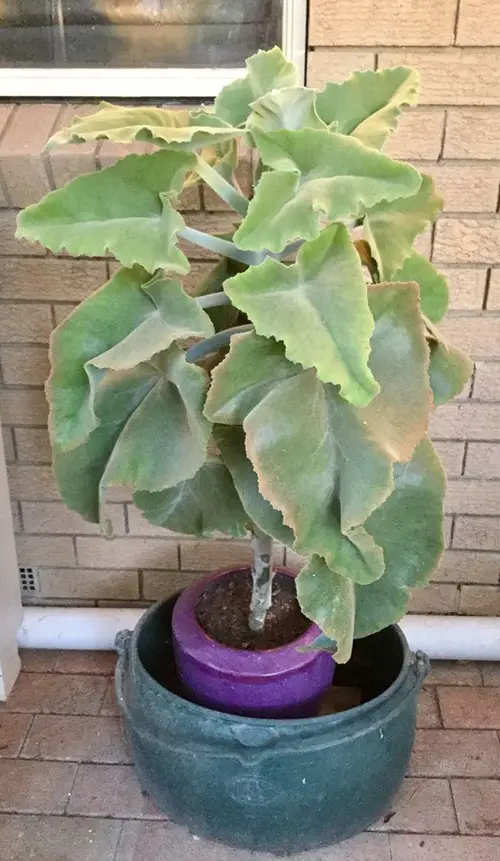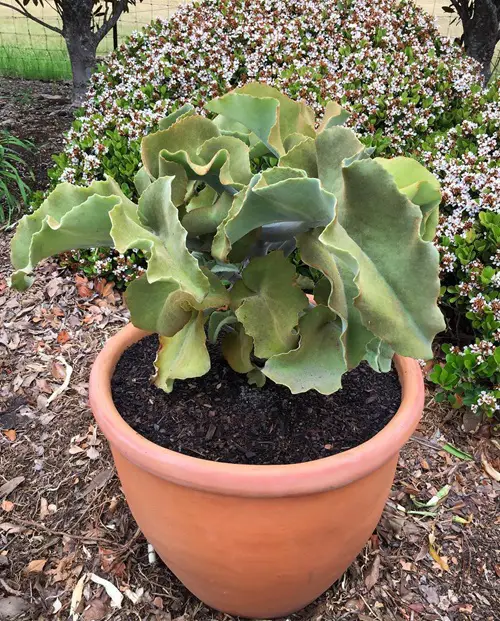Want to have an easy-to-maintain and unique plant? Here is everything about Kalanchoe beharensis care and its growing needs.

If you want to have a tree-like shrub in your garden, Kalanchoe beharensis is deeply admired by many gardening lovers for its velvety leaves and medical purposes. This article will cover how to grow Elephant Ear Kalanchoe with easy tips!
Kalanchoe beharensis- Key Facts
| Botanical Name | Kalanchoe beharensis |
| Common Names | Velvet Leaf, Felt Plant, Elephant Ear Kalanchoe |
| USDA Zones | 11-12 |
| Size | 10-12 feet tall |
| Flowering | Small, Tubular Yellow-green flowers in the winter |
| Light | Bright, indirect light to direct sunlight |
| Humidity | Low humidity |
| Temperature | 60F-85F |
| Soil | Well-draining Soil |
| Watering | Thorough watering but avoid overwatering |
| Fertilizer | Liquid fertilizer in Spring and Summer |
| Pest & Diseases | Susceptible to mealybugs and spider mites |
| Propagation | Stem and Leaf cuttings |
| Uses | Houseplant or Outdoor landscaping. The leaves are also used for medicinal purposes in some cultures. |
Plant Information
Kalanchoe beharensis is also popular by several names, Velvet-Leaf, Felt Bush, or Elephant’s Ear Kalanchoe. Straight from the terrains of Behara, Madagascar, this unique plant is very adaptable. When planted, it reaches around 3-5 feet, but in its natural habitat, it can soar up to 12-20 feet like a tree!
Elephant Ear Kalanchoe features woody trunks and branches that hold large, arrowhead-shaped leaves ranging from 5 to 14 inches in length and width. In addition, it also produces clusters of small, greenish-yellow flowers, which are a little less noticeable in comparison to its foliage.
Fun Fact: The genus Kalanchoe derives from an ancient, now-corrupted Chinese word, reflecting the plant’s long-standing cultural significance.
Kalanchoe beharensis Propagation
The best and easiest way of propagating this succulent is via stem or leaf cuttings.
Leaf Cuttings
Start by selecting a mature, healthy leaf from the mother plant and gently separate it by slightly twisting it or using a sharp clipper to snip it off. Be careful and gentle while doing it to avoid any damage to the plant. Allow the cuttings to dry for a few days then stick them into the soil and spray a little water.
Keep the pot in bright indirect light and spray water when the soil seems dry. You can observe rooting in 3 to 4 weeks and soon they will start to grow into a new plant.
Stem Cuttings
In almost the same manner, use sterilized pruners or cutters to cut the stems (2-3 inches in length) from a healthy branch and let them dry for a few days (2-3 days). Make sure you cut 1-2 cm below a node for successful rooting. When it forms callus you will know that now you can plant them in soil. The soil must be well-draining and you need to water sparingly—only when the top inch of soil is dry.
Pro Tip: Keep it under bright light and away from the harsh sunlight until it establishes itself.
Pot Size for Kalanchoe beharensis
For young plants or cuttings you can take a small pot that is about 4-6 inches in diameter and for mature plants opt for a medium-sized pot that is 8-12 inches in diameter. Make sure the pot is wide enough to accommodate the plant’s spread and deep enough to hold its roots easily.
Pro Tip: Avoid using overly large pots, as excess soil can retain water and lead to root rot! And, always prioritize drainage holes.
Requirements For Growing Kalanchoe beharensis

Sunlight
Kalanchoe succulents can tolerate full sun exposure but prefer to thrive better in partial sun. So that it is a good choice for indoor as well as outdoor placements.
Soil
As a succulent, it needs a well-draining potting mix that is filled with nutrients and porous particles like sandy soil, coco peat or husk, perlite, etc. The medium should not hold water for too long. You can use a good succulent or cactus soil mix that is readily available in stores.
Watering
This plant flourishes gracefully if you take care of it. Likewise, if you take care of your watering routine, your Kalanchoe beharensis will grow abundantly. However, always check the top inch layer of the soil before pouring in water to avoid overwatering.
Temperature
The Elephant Ear Kalanchoe loves warm climates so it is obvious that it doesn’t tolerate cold climates or frost! You can always bring them inside during the winter season or grow them as houseplants if you live in a colder region.
Care For Kalanchoe beharensis

Fertilizer
To keep your Kalanchoe thriving, feed it with a balanced liquid fertilizer diluted to half-strength during its growing season. You can fertilize every 4-6 weeks but avoid over-feeding. Also, remember to not fertilize during the winter season—it’s a dormant period.
Pests and Diseases
It is generally a hardy plant however, it can occasionally face issues with mealybugs and spider mites. These pests can be removed by wiping the leaves with a cotton ball soaked in diluted rubbing alcohol (50-70% alcohol is great).
Root rot can occur if you overwater your plant, so always ensure the soil is well-draining and dry before watering. Besides, regularly inspect for any signs of infestations or diseases to prevent much damage.
So, are you ready to bring this beauty home? Let us know when you are planning to do so because we would love to hear from you!









